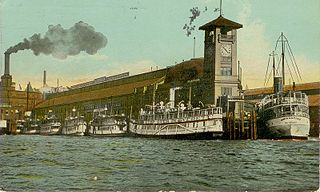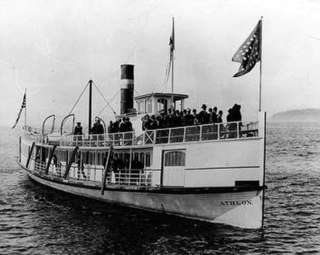
The Puget Sound mosquito fleet was a multitude of private transportation companies running smaller passenger and freight boats on Puget Sound and nearby waterways and rivers. This large group of steamers and sternwheelers plied the waters of Puget Sound, stopping at every waterfront dock. The historical period defining the beginning and end of the mosquito fleet is ambiguous, but the peak of activity occurred between the First and Second World Wars.

Lake Washington steamboats and ferries operated from about 1875 to 1951, transporting passengers, vehicles and freight across Lake Washington, a large lake to the east of Seattle, Washington. Before modern highways and bridges were built, the only means of crossing the lake, other than the traditional canoe or rowboat, was by steamboat, and, later, by ferry. While there was no easily navigable connection to Puget Sound, the Lake Washington Ship Canal now connects Lake Washington to Lake Union, and from there Puget Sound is reached by way of the Hiram M. Chittenden Locks.

The King and Winge Shipbuilding Company was an important maritime concern in the early 1900s on Puget Sound. The shipyard was located at West Seattle. The owners were Thomas J. King (1843–1925) and Albert M Winge. King was born in Boston and learned to build ships under the famous Donald McKay. He came to Puget Sound in about 1880, and worked in the shipyards of Hall Bros. and T.W. Lake before starting his own shipyard with Winge. King’s partner, Albert L. Winge was a native of Norway.

Athlon was a typical passenger steamboat of the Puget Sound Mosquito Fleet.

The steamboat Monticello (2) operated in the early 1900s as part of the Puget Sound Mosquito Fleet. The vessel went through several reconstructions and remained in service until 1962, when she was lost in Alaska waters. Her later names were Penaco and Sea Venture. (This Puget Sound steamer should not be confused with the smaller Monticello, which also ran on Puget Sound, but was built in 1895 for Captain Z.J. Hatch of the Monticello Steamship Company.

The steamboat Yosemite operated for almost fifty years on San Francisco Bay, the Sacramento River, inland coastal waters and the lower Fraser River in British Columbia, and Puget Sound.

Olympian was a large side-wheel inland steamship that operated in the Pacific Northwest and Alaska. Olympian operated from early 1884 to late 1891 on the Columbia River, Puget Sound, and the Inside Passage of British Columbia and Alaska.

The PS Eliza Anderson operated from 1858 to 1898 mainly on Puget Sound, the Strait of Georgia, and the Fraser River but also for short periods in Alaska. She was generally known as the Old Anderson and was considered slow and underpowered even for the time. Even so, it was said of her that "no steamboat ever went slower and made money faster." She played a role in the Underground Railroad and had a desperate last voyage to Alaska as part of the Klondike Gold Rush.

The steamboat Rosalie operated from 1893 to 1918 as part of the Puget Sound Mosquito Fleet, also operating out of Victoria, B.C. In 1898, Rosalie went north with many other Puget Sound steamboats to join the Klondike Gold Rush.

The Greyhound was an express passenger steamer that operated from the 1890s to about 1915 on Puget Sound in Washington, United States. This vessel, commonly known as the Hound, the Pup, or the Dog, was of unusual design, having small upper works, but an enormous sternwheel. Unlike many sternwheelers, she was not intended for a dual role as passenger and freighter, but was purpose-built to carry mostly passengers on express runs.

Flyer was an American steamboat that served from 1891 to 1929 on Puget Sound. From 1918 until the end of her service, she was officially known as the Washington. The Flyer ran for millions of miles at high speed, more than any inland vessel in the world. This 1891 steamer Flyer should not be confused with the steamboat Flyer built on Lake Coeur d'Alene in 1905, although the Coeur d'Alene vessel was inspired both in design and name by the success of the Puget Sound ship.

The sidewheeler Idaho was a steamboat that ran on the Columbia River and Puget Sound from 1860 to 1898. There is some confusion as to the origins of the name; many historians have proposed it is the inspiration for the name of the State of Idaho. Considerable doubt has been cast on this due to the fact that it is unclear if the boat was named before or after the idea of 'Idaho' as a territory name was proposed. John Ruckel also allegedly stated he had named the boat after a Native American term meaning 'Gem of the Mountains' he got from a mining friend from what is now Colorado territory. This steamer should not be confused with the many other vessels of the same name, including the sternwheeler Idaho built in 1903 for service on Lake Coeur d'Alene and the steamship Idaho of the Pacific Coast Steamship Line which sank near Port Townsend, Washington.

Tacoma was a steamship that served from 1913 to 1938 on Puget Sound. Built of steel, Tacoma was known for being one of the fastest and best-designed vessels to operate on Puget Sound. Tacoma was particularly noted for high-speed service from 1913 to 1930 on the route between Tacoma and Seattle.

North Pacific was an early steamboat operating in Puget Sound, on the Columbia River, and in British Columbia and Alaska. The vessel's nickname was "the White Schooner" which was not based on the vessel's rig, but rather on speed, as "to schoon" in nautical parlance originally meant to go fast.

Hyak was a wooden-hulled steamship that operated on Puget Sound from 1909 to 1941. This vessel should not be confused with the sternwheeler Hyak which ran on the extreme upper reach of the Columbia River at about the same time. The name means "swift" or "fast" in the Chinook Jargon.
The La Conner Trading and Transportation Company was founded in the early 1900s by Joshua Green and others, to engage in the shipping business on Puget Sound.

Richard Holyoke was a seagoing steam tug boat built in 1877 in Seattle, Washington and which was in service on Puget Sound and other areas of the northwest Pacific coast until 1935. The vessel was considered to be one of the most powerful tugs of its time.

Inland Flyer was a passenger steamboat that ran on Puget Sound from 1898 to 1916. From 1910 to 1916 this vessel was known as the Mohawk. The vessel is notable as the first steamer on Puget Sound to use oil fuel. Inland Flyer was one of the most famous vessels of the time on Puget Sound.

General Miles was a steamship constructed in 1882 which served in various coastal areas of the states of Oregon and Washington, as well as British Columbia and the territory of Alaska. It was apparently named after US General Nelson A. Miles.

Kulshan was a steamship which operated on Puget Sound from 1910 until 1929. When built, Kulshan was one of a newer type of inland steamships constructed entirely of steel, and was then considered one of the finest vessels ever to operate on Puget Sound.





















